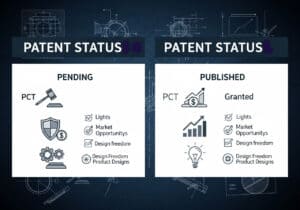In 2022, 3.5 million patents were given out all over the world. This shows how crucial intellectual property is for global innovation. Understanding the brevetto vs copyright differences is essential for protecting inventions and artistic works. Patents mainly focus on tech advancements. Copyrights protect artistic works.
Se i creatori e gli inventori comprendono queste leggi, possono proteggere il loro lavoro. Questa protezione porta a una maggiore creatività e a maggiori opportunità.
Even though they’re both under intellectual property, patents and copyrights serve different purposes. In the US, patents make up about 90% of all issued protections. They give rights that help turn ideas into assets. On the other hand, copyright law protects authors and creators. It gives them control over copying and sharing their work publicly.
Explaining patent vs copyright isn’t just for academics. It’s crucial for those wanting to promote innovation and make the most of their intellectual efforts.
Punti Chiave
- Intellectual property rights are key for legal protection and making money from inventions and creative works.
- Patents provide exclusive rights important for tech innovation and its industrial use.
- I diritti d'autore consentono di controllare la copia e la condivisione di opere artistiche e letterarie originali.
- Il diritto dei marchi aiuta le imprese a proteggere il proprio marchio e a mantenere la fiducia dei consumatori attraverso la registrazione federale.
- Knowing the differences between patents, copyrights, and trademarks can majorly affect business tactics and creative freedom.
- The terms of legal protection for these rights affect how long they last and how they’re enforced.
Comprendere i fondamenti della proprietà intellettuale
Proprietà intellettuale (IP) è un'area chiave per promuovere innovazione e creatività in diversi settori. La comprensione dei fondamenti della proprietà intellettuale aiuta a proteggere prodotti unici e iniziative creative. Questo garantisce diritti esclusivi e un vantaggio competitivo.
Definire la proprietà intellettuale (PI)
Proprietà intellettuale protegge le creazioni in campo industriale, scientifico, letterario e artistico. Dà ai creatori il diritto di controllare e utilizzare legalmente il loro lavoro. Questi diritti riguardano nuovi prodotti e processi innovativi.
I quattro pilastri della proprietà intellettuale: copyright, brevetto, marchio e segreto commerciale
- Diritto d'autore: protects creators of original works like literature, music, and art. It allows them to control reproduction, distribution, and display.
- Brevetto: gives inventors rights to their inventions for up to 20 years. This includes machines, processes, or chemical compositions.
- Marchio di fabbrica: identifies the source of goods or services with unique signs. Names, logos, and symbols can be registered for protection.
- Trade secret: keeps business information confidential, including formulas and processes. It provides a competitive advantage.
Perché è importante distinguere tra i diversi diritti di proprietà intellettuale
Understanding different IP rights is key for proper legal protection. For example, copyright protects creative work’s idea expression. Patents protect technical inventions that are new and useful. Knowing the differences is crucial for maximizing innovation potential.
Questa conoscenza garantisce la conformità alle leggi, proteggendo i beni da un uso improprio. La protezione totale della proprietà intellettuale promuove una cultura di integrità e innovazione.
Che cos'è la protezione del copyright?
Exploring copyright law reveals how copyright protection keeps original creations safe. It makes sure the unique touch and originality of works like books, songs, or plays are kept. This is vital for creators to maintain their unique contributions.
Il concetto di originalità nelle opere creative
Nella legge sul diritto d'autore, originalità è fondamentale per ottenere la protezione. Un'opera deve mostrare l'abilità e il giudizio del creatore. Non è sufficiente copiare opere esistenti. I diritti d'autore proteggono il modo in cui le idee vengono mostrate, non le idee stesse, a differenza dei brevetti.

Ambito e limiti della legge sul diritto d'autore
IL ambito di applicazione della legge sul diritto d'autore è ampio. Copre opere come libri, opere teatrali, musica e arte. Gli autori possono controllare l'uso delle loro opere ed essere pagati. Le leggi sul copyright hanno lo scopo di motivarli economicamente. Esistono tuttavia dei limiti, come il fair use, che consente di utilizzare materiale protetto da copyright senza bisogno di autorizzazione.
La comprensione di questi dettagli aiuta a orientarsi meglio nelle regole del copyright.
Vantaggi della registrazione presso l'Ufficio del copyright statunitense
Il diritto d'autore inizia non appena un'opera viene realizzata e fissata in una forma tangibile. Ma la registrazione presso il Ufficio del copyright degli Stati Uniti aumenta questa protezione. La registrazione è fondamentale per intraprendere azioni legali o gestire i problemi di copyright. Rafforza il legame tra i diritti e la possibilità di farli valere.
| Aspetto | Dettaglio |
|---|---|
| Necessità di registrazione | Volontario, ma richiesto in caso di contenzioso |
| Protezione alla creazione | Diritto automatico al momento della creazione e della fissazione dell'opera |
| Durata del copyright | Vita del creatore più 70 anni, fino a 95 o 120 anni per le opere su commissione. |
| Danni legali | Disponibile al momento della registrazione |
| Ambito di applicazione della legge | Opere letterarie, drammatiche, musicali e artistiche |
La registrazione di un copyright è fondamentale. Esso sostiene i diritti morali e legali dei creatori. Questo li aiuta a proteggere il originalità del loro opere creative.
Navigare nel diritto dei brevetti
The world of patent law boosts innovation and tech progress. It gives inventors exclusive rights to their work. Knowing the types of patents and how to get them from the U.S. Patent and Trademark Office is key for inventors.
Negli Stati Uniti esistono tre brevetti principali: di utilità, di design e di stabilimento. I brevetti di utilità sono i più comuni e coprono nuovi processi e macchinari. I brevetti di design proteggono l'aspetto di un oggetto. I brevetti per le piante riguardano nuovi tipi di piante che non si riproducono tramite semi.
IL Legge America Invents ha cambiato il sistema brevettuale statunitense. Ora si tratta di chi deposita per primo, non di chi inventa per primo. Questo fa sì che il deposito rapido del brevetto Ufficio brevetti e marchi statunitense molto importante.
| Tipo di brevetto | Protezione offerta | Durata |
|---|---|---|
| Brevetto di utilità | Aspetti funzionali delle invenzioni | 20 anni |
| Brevetto di design | Aspetto estetico degli oggetti | 15 anni |
| Brevetto vegetale | Nuove varietà di piante | 20 anni |
Getting a patent is hard and often requires a lawyer. A good patent attorney is essential. They make sure your invention is protected right, following the rules of the U.S. Patent and Trademark Office.
Patent laws don’t just help inventors keep their exclusive rights. They also promote non-stop innovation and economic growth.
Il dominio dei marchi e dei marchi di servizio
Marchi di fabbrica E marchi di servizio are very important in the business world. They help identify a brand and show a business’s reputazione and the quality it offers. They make a brand stand out from others, building customer loyalty and trust.
Identificazione della fonte di beni e servizi
Marchi di fabbrica E marchi di servizio sono fondamentali per mostrare la provenienza di un prodotto o di un servizio. Questo aiuta i consumatori a scegliere in base ai nomi dei marchi. Questa scelta è influenzata dal grado di riconoscimento e di fiducia nel marchio.
Vantaggi legali della registrazione di un marchio presso l'USPTO
There are many benefits to registering a trademark with the USPTO. It offers nationwide protection, very important for keeping a brand safe in the U.S. This federal status helps prevent others from using your mark and makes legal actions easier if needed. Also, USPTO registration proves you own the mark,...
Avete letto 30% dell'articolo. Il resto è per la nostra comunità. Sei già un membro? Accedi
(e anche per proteggere i nostri contenuti originali dai bot di scraping)
Comunità Innovazione.mondo
Accedi o registrati (100% free)
Visualizza il resto di questo articolo e tutti i contenuti e gli strumenti riservati ai soci.
Solo veri ingegneri, produttori, designer, professionisti del marketing.
Nessun bot, nessun hater, nessuno spammer.
Domande frequenti
Quali sono le principali differenze tra un brevetto e un copyright?
I brevetti riguardano le nuove invenzioni, come le macchine o le sostanze chimiche. Contribuiscono all'innovazione e al progresso. I diritti d'autore proteggono le opere creative come libri, musica e arte. Si concentrano sui diritti del creatore.
Che cos'è la proprietà intellettuale (PI)?
La PI riguarda le idee e le creazioni della vostra mente. Include invenzioni, opere artistiche e progetti. La PI conferisce al creatore diritti speciali sul proprio lavoro.
Perché è importante comprendere i diversi tipi di diritti di proprietà intellettuale?
Conoscere i diritti di proprietà intellettuale aiuta i creatori a proteggere il proprio lavoro. Permette loro di utilizzare metodi legali per difendere i propri diritti. Inoltre, possono trarre il massimo profitto dalle loro creazioni.
Che cosa costituisce l'originalità nelle opere creative che si qualificano per la protezione del diritto d'autore?
Originalità significa che l'autore ha realizzato l'opera da solo, con una certa creatività. Non deve essere totalmente nuova, ma solo non copiata.
Quali sono i vantaggi di registrare un'opera presso l'U.S. Copyright Office?
La registrazione consente di ottenere un registro pubblico dei diritti d'autore. Può comportare grandi vantaggi legali, come il risarcimento dei danni in tribunale. Ma la registrazione deve avvenire prima di qualsiasi violazione o entro tre mesi dalla pubblicazione.
Quali diritti ha il titolare di un brevetto?
Il titolare di un brevetto può impedire ad altri di utilizzare la sua invenzione per 20 anni. Questo significa che può guadagnare solo da essa.
Perché è importante registrare i marchi di fabbrica e di servizio?
La registrazione offre vantaggi legali. Il marchio diventa di vostra proprietà ovunque negli Stati Uniti e vi aiuta anche in tribunale e nella registrazione in altri Paesi.
In che modo il diritto d'autore si sovrappone al diritto dei marchi?
A volte le leggi sul copyright e sui marchi coprono la stessa cosa. Ad esempio, quando l'aspetto di un logo è protetto da copyright ma viene utilizzato anche come marchio.
Qual è il ruolo dell'Ufficio brevetti e marchi degli Stati Uniti (USPTO) nei brevetti?
L'USPTO controlla i brevetti per verificarne la legittimità. Rilascia i brevetti per proteggere le invenzioni. Gestisce anche tutti i registri dei brevetti.
Quanto durano le protezioni di copyright e brevetti?
Il diritto d'autore dura per tutta la vita dell'autore più 70 anni. I brevetti durano 20 anni dal momento della richiesta, se si pagano le tasse.
Quando è opportuno utilizzare i segreti commerciali al posto dei brevetti o dei diritti d'autore?
Utilizzate i segreti commerciali quando volete mantenere segrete le informazioni per sempre. Sono protetti finché sono preziosi e segreti.
In che modo la comprensione dell'interazione tra le diverse leggi sulla PI può influire sulla protezione della proprietà intellettuale?
Conoscere il funzionamento delle leggi sulla proprietà intellettuale aiuta a proteggere e gestire meglio le vostre creazioni. Significa che potete usare i vostri diritti in modo più efficace.
In che modo lo sfruttamento dei diritti di proprietà intellettuale può fornire un vantaggio competitivo negli affari?
I diritti di proprietà intellettuale vi danno il controllo sulle vostre creazioni e proteggono la vostra attività. Rendono i vostri prodotti più preziosi. Inoltre, contribuiscono a creare nuovi profitti e a costruire il vostro marchio.
Link esterni sulla protezione della proprietà intellettuale
Standard internazionali
Link di interesse
(passa il mouse sul link per vedere la nostra descrizione del contenuto)
Glossario dei termini utilizzati
Digital Rights Management (DRM): un insieme di tecnologie di controllo degli accessi utilizzate per proteggere i contenuti digitali protetti da copyright dall'uso, dalla copia e dalla distribuzione non autorizzati, garantendo che i creatori e i distributori mantengano il controllo sui propri diritti di proprietà intellettuale.
Fair Use Doctrine: un principio legale che consente un uso limitato di materiale protetto da copyright senza l'autorizzazione del titolare dei diritti, in genere per scopi quali critica, commento, informazione, insegnamento, borse di studio o ricerca, bilanciando gli interessi dei titolari del copyright e del pubblico.
Non-Disclosure Agreement (NDA): Contratto legale che stabilisce un rapporto di riservatezza tra le parti, vietando la divulgazione di informazioni specifiche a terzi. È comunemente utilizzato per proteggere le informazioni sensibili condivise durante trattative commerciali o collaborazioni.
Public Domain: Uno status legale che indica che le opere sono libere da restrizioni di copyright, consentendo a chiunque di utilizzarle, modificarle e distribuirle senza autorizzazione o pagamento. Questo status può derivare dalla scadenza del copyright, da una dedizione esplicita da parte dell'autore o dalla mancanza di idoneità al copyright.
Unique Selling Point (USP): una caratteristica o un vantaggio distintivo che distingue un prodotto o un servizio dai concorrenti, volto ad attrarre i clienti rispondendo a esigenze o preferenze specifiche.
United States Patent & Trademark Office (USPTO): Agenzia federale responsabile della concessione di brevetti e della registrazione di marchi negli Stati Uniti, della promozione dell'innovazione e della tutela dei diritti di proprietà intellettuale. Esamina le domande, rilascia brevetti e gestisce un database dei marchi registrati.
User Interface (UI): un sistema che consente l'interazione tra utenti e applicazioni software, comprendendo elementi visivi, controlli e layout generale per facilitare le attività dell'utente e migliorare l'esperienza.



























contesti internazionali?
Sarebbe utile un approfondimento sulle differenze internazionali di queste leggi.